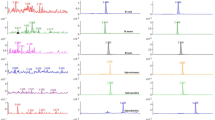Abstract
The present study aimed at determining selected alkaloid components in the nectar of Datura species, to elucidate whether the alkaloid content of the floral nectar can lead to intoxication. A simple and rapid liquid chromatography coupled with electrospray mass spectrometry analysis was developed for the quantitative determination of atropine and scopolamine, the main toxic alkaloids of the Datura species. This method allowed the direct coupling of an electrospray mass selective detector to the LC system. Under these conditions, atropine and scopolamine were well separated from other components and detected with mass spectrometry (mass selective detector). Simultaneous determination of atropine and scopolamine was performed with gradient elution on an Ascentis Express C18 (Supelco) reversed-phase column based on a new fused core particle design. Liquid chromatography coupled with electrospray mass spectrometry was used in positive ion mode. Atropine and scopolamine produced protonated species at m/z 290 and 304 (which are also the base peaks). Our data confirmed that the alkaloid characteristics for the vegetative and reproductive parts of the Datura plants may also occur in the nectar secreted by the flowers. In Datura species with large flowers and high nectar amounts, the alkaloid content increases proportionately and thus the nectar may be a potential source of intoxication.





Similar content being viewed by others
References
Rätsch C (2007) Enzyklopädie der psychoaktiven Pflanzen. AT Verlag, Schweiz, pp 194–218
Birmes P, Chounet V, Mazerolles M, Cathala B, Schmitt L, Lauque D (2002) Presse Med 31:69–72
Diker D, Markovitz D, Rothman M, Sendovski U (2007) Eur J Intern Med 18:336–338. doi:10.1016/j.ejim.2006.09.035
Hanna JP, Schmidley JW, Braselton WE (1992) Clin Neuropharmacol 15:109–113
Chan TY (1995) Vet Hum Toxicol 37:156–157
Bruneton J (1999) Toxic plants dangerous to humans and animals. Intercept, Hampshire, p 465
van Wyk B-E, van Oudtshoorn B, Gericke N (1997) Medicinal plants of South Africa. Briza Publications, Pretoria, pp 102–103
van Wyk B-E, van Heerden FR, van Oudtshoorn B (2002) Poisonous plants of South Africa. Briza Publications, Pretoria, pp 86–87
van Wyk B-E, Gericke N (2000) Peoples’s plants. Briza Publications, Pretoria, p 162
The Merck Index on CD ROM, Version 12.2 (1997)
Dictionary of Natural Products, CRC Press, CD-ROM, Version 11.2 (2003)
Friedman M (2004) J Chromatogr A 1054:143–155. doi:10.1016/j.chroma.2004.04.049
Miklós EJ, Botz L, Gy Horváth, Farkas Á, Gy Dezső, LGy Szabó (2001) Int J Hortic Sci 7:61–64
Miraldi E, Masti A, Ferri S, Comparini IB (2001) Fitoterapia 72:644–648
Afsharypuor S, Mostajeran A, Mokhtary R (1995) Planta Med 61:383–384
Berkov S, Zayed R (2004) Z Naturforsch C 59:184–186
Ionkova I, Witte L, Alfermann AW (1989) Planta Med 55:229–230
Lindequist U (1992) Datura. In: Hagers Handbuch der pharmazeutischen Praxis, 5th edn, Springer, Berlin, pp 1138–1154
Hiraoka N, Tashimo K, Kinoshita C, Hirooka M (1996) Biol Pharm Bull 19:1086–1089
Siddiqui S, Sultana H, Ahmed SS, Haider SI (1986) J Nat Prod 49:511–513
Vitale AA, Acher A, Pomilio AB (1995) J Ethnopharmacol 49:81–89
Doncheva C, Berkov S, Philipov S (2006) Biochem Syst Ecol 34:478–488
Grant V, Grant KA (1983) Bot Gaz 144:280–284
Khalil S (1999) J Pharm Biomed 21:697–702
El Ries MA, Khalil S (2001) J Pharm Biomed 25:3–7
Dräger B (2002) J Chromatogr A 978:1–35
Namera A, Yashiki M, Hirose Y, Yamaji S, Tani T, Kojima T (2002) Forensic Sci Int 130:34–43
Kagale S, Marimuthu T, Thayumanavan B, Nandakumar R, Samiyappan R (2004) Physiol Mol Plant Pathol 65:91–100. doi:10.1016/j.pmpp.2004.11.008
Mroczek T, Głowniak K, Kowalska J (2006) J Chromatogr A 1107:9–18. doi:10.1016/j.chroma.2005.12.034
Cherkaoui S, Mateus L, Christen P, Veuthey J-L (1998) J Pharm Biomed 17:1167–1176
Eeva M, Salo J-P, Oksman-Caldentey K-M (1998) J Pharm Biomed 16:717–722
Bo T, Li KA, Liu H (2003) J Pharm Biomed 31:885–891
Mateus L, Cherkaoui S, Christen P, Oksman-Caldentey K-M (2000) Phytochemistry 54:517–523
Zárate R, Hermosin B, Cantos M, Troncoso A (1997) J Chem Ecol 23:2059–2066
Kursinszki L, Hank H, László I, Szőke É (2005) J Chromatogr A 1091:32–39. doi:10.1016/j.chroma.2005.07.016
Rbeida O, Christiaens B, Hubert Ph, Lubda D, Boos K-S, Crommen J, Chiap P (2005) J Pharm Biomed 36:947–954
Ceyhan T, Kartal M, Altun ML, Tülemis F, Cevheroglu S (2001) J Pharm Biomed 25:399–406
Niño J, Gallego CM, Correa YM, Mosquera OM (2003) Plant Cell Tissue Organ 74:289–291
Chen H, Chen Y, Du P, Han F, Wang H, Zhang H (2006) J Pharm Biomed 40:142–150. doi:10.1016/j.jpba.2005.06.027
Chen HX, Chen Y, Du P, Han FM (2007) Chromatographia 65:413–418. doi:10.1365/s10337-007-0187-9
Oertel R, Richter K, Ebert U, Kirch W (2001) J Chromatogr B 750:121–128
Abbara C, Bardot I, Cailleux A, Lallement G, Le Bouil A, Turcant A, Clair P, Diquet B (2008) J Chromatogr B 874:42–50. doi:10.1016/j.chromb.2008.08.027
Steenkamp PA, Harding NM, van Heerden FR, van Wyk B-E (2004) Forensic Sci Int 145:31–39. doi:10.1016/j.forsciint.2004.03.011
Gaillard Y, Pepin G (1999) J Chromatogr B 733:181–229
Moffat AC, Osselton MD, Widdop B (eds) (2003) Clarke’s analysis of drugs and poisons, 3rd edn. Pharmaceutical Press, London
Acknowledgments
The work was supported by the grants GVOP-3.2.1-0168, RET 008/2005, OTKA-NKTH NI-68863, OTKA K75717, OTKA F48815. Simkon Ltd. (Budapest, Hungary) and Sigma-Aldrich Ltd. (Budapest, Hungary) are thanked for lending the Ascentis Express C18 column.
Author information
Authors and Affiliations
Corresponding author
Rights and permissions
About this article
Cite this article
Boros, B., Farkas, Á., Jakabová, S. et al. LC-MS Quantitative Determination of Atropine and Scopolamine in the Floral Nectar of Datura Species. Chroma 71 (Suppl 1), 43–49 (2010). https://doi.org/10.1365/s10337-010-1524-y
Received:
Revised:
Accepted:
Published:
Issue Date:
DOI: https://doi.org/10.1365/s10337-010-1524-y




